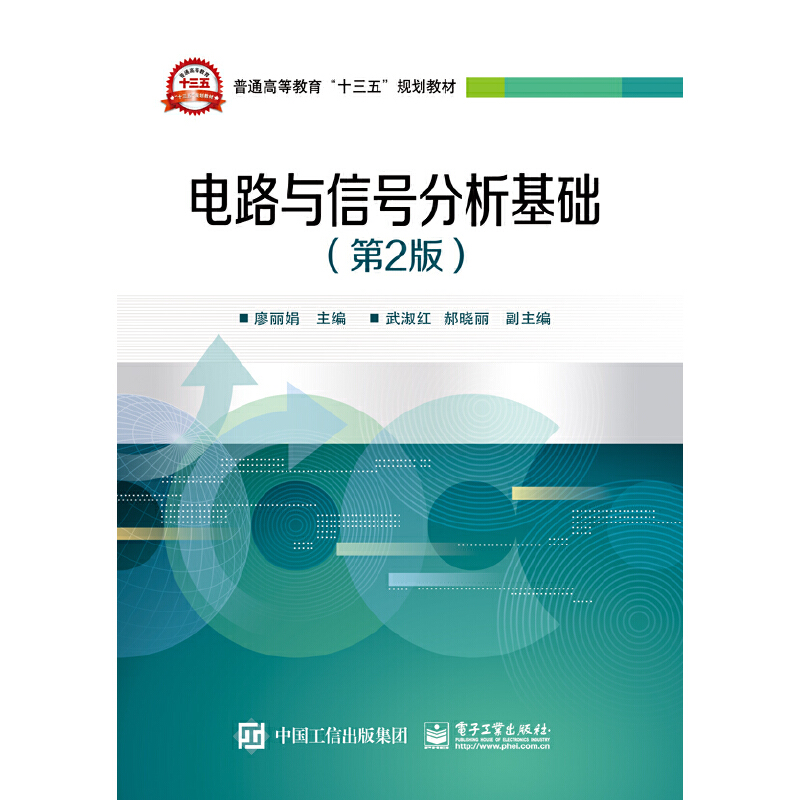电路分析原理 / 北京大学信息科学技术学院系列教材
作者: 胡薇薇
出版时间:2014年10月
出版社:清华大学出版社
- 清华大学出版社
- 9787302372943
- 70583
- 0045157684-7
- 16开
- 2014年10月
- TM133
- 电类
- 本科
为了使学生们在学习和选择参考书时减少困惑,本书力图体现如下特点:力图阐述得更清楚、更简明、更有条理、更容易理解和掌握;力图以简明、清晰、条理、渐进、渊源的方式说明和强调基本概念、基本方法和基本定理;配合双语教学,书中的标题和一些必要的名词、术语、概念、原理均辅以英文书写,各章练习题以中英双语书写;习题三星分级,辅以自学自测。
本书可作为高等学校电类基础课“电路分析”的教材,并可供其他相关人员参考使用。
引子——人类认识电的历史
第1章 线性电路分析基础Introduction & Basic Analysis of Linear Circuit
1.1 线性电路基本概述/Basic Introduction to Linear Circuit
1.1.1 基本单位/Units and Scales
1.1.2 集总假设及集总电路模型/Lumped-Parameter Circuit
1.1.3 基本参数、变量和参考方向/Basic Components、Parameters and Reference Direction
1.1.4 基本定律/Basic Laws
1.2 常见电路元件模型及其约束方程/Elements and Element Constraints
1.2.1 元件的分类/Kinds of Conponents
1.2.2 电阻元件/Resistor
1.2.3 理想独立电压源与理想独立电流源/Independent Sources
1.2.4 电容元件/Capacitor
1.2.5 电感元件/Inductor
1.2.6 理想受控源/Controlled Source or Dependent Source
1.3 典型源信号和响应信号/Basic Signals and Functions
1.4 线性二端(单口)网络的等效/Equivalence of One-Port Network
1.4.1 等效的定义/Definition of Equivalence
1.4.2 电阻电路的等效/Equivalence of Resistive Circuits
1.4.3 具有初始储能(初始值)的动态元件的等效/Equivalence of Dynamic Connections
1.4.4 源电路的等效/Equivalence of Sources
总结与回顾Summary and Review
练习与习题Exercises and Problems
第2章 线性电路的时域分析Basic Analysis of Linear Circuit in Time domain
2.1 动态电路的暂态过程和起始状态/Introduction of Transient Analysis
2.1.1 静态电路与动态电路/Static and Dynamic Circuit
2.1.2 静态电路分析/Resistive Circuit
2.1.3 动态电路的换路、起始状态和暂态过程/Switch and Initial State
2.2 一阶动态电路分析/Analysis of First-Order Circuit
2.2.1 RL或RC电路分析/RL or RC Circuit
2.3 动态电路的零状态响应/Zero State Response
2.3.1 复指数信号及正弦信号激励的零状态响应/Sinusoidal Excitation
2.3.2 单位阶跃响应s(t)和单位冲激响应h(t)/Unit-Step Response and Unit Impulse Response
2.3.3 任意信号激励的零状态响应/Arbitrary Excitation
2.4 二阶及高阶动态电路分析/Second-Order Circuits and High-Order Circuits
2.4.1 响应的求解/Functions and Solutions
2.4.2 电路的稳定性分析/Stability Analysis
总结与回顾Summary and Review
附录A 一元 n次常参量微分方程的求解/Solution of Linear Differential Equations
A.1 一阶线性常参量微分方程的求解/First Order
A.2 n阶微分方程的求解/n Order
练习与习题Exercises and Problems
第3章 正弦稳态电路分析Sinusoidal Steady-State Analysis
3.1 正弦稳态电路分析/Sinusoidal Steady-State Analysis
3.1.1 正弦信号的复数表示——相量/Phasors
3.1.2 电路中的复数表示——相量模型/Phasor Model in Circuit
3.1.3 正弦稳态电路分析/Sinusoidal Steady-State Analysis
3.2 正弦稳态功率/Powers
3.3 网络函数与频率响应/Network Functions and Frequency Responses
3.4 滤波器/Filter
3.4.1 一阶滤波器/First-Order Filter(Low-Pass,High-Pass)
3.4.2 二阶滤波器/Second-Order Filter(Band Pass,Bandstop)
总结与回顾Summary and Review
练习与习题Exercises and Problems
第4章 电路的变换域分析——拉普拉斯变换Laplace Transform
4.1 拉普拉斯变换/Laplace Transform
4.1.1 变换域分析/Transform Analysis
4.1.2 拉氏变换定义/Definition of the Laplace Transform
4.1.3 拉氏变换的基本性质/Basic Theorems for the Laplace Transform
4.1.4 拉氏反变换——分解定理/Inverse Laplace Transform
4.2 线性电路的s域求解/Circuit Analysis in the s-Domain
4.2.1 元件的s-域模型/Components in the s-Domain
4.2.2 定律的s域形式/Laws in the s-Domain
4.2.3 线性电路的s域求解/Circuit Analysis in the s-Domain
4.3 网络函数的s域描述/Network Function in the s-Domain
4.3.1 定义/Definition
4.3.2 网络函数的特性/Characteristic Analysis
总结与回顾Summary and Review
练习与习题Exercises and Problems
第5章 信号的变换域分析——傅里叶变换Fourier Analysis
5.1 傅里叶级数/The Fourier Series
5.1.1 周期信号的傅氏级数表示/Three Forms of the Fouries Series
5.1.2 周期信号的对称性与傅氏级数之间的关系/Symmetry of Fourier Series
5.1.3 常见周期信号的傅氏级数/Some Useful Fourier Series
5.1.4 周期信号的平均功率和有效值/Average Power and Effective Values of Periodic Functions
5.1.5 周期信号作用于线性电路的稳态响应/Steady-State Responses
5.2 傅氏变换:非周期信号的频谱分析/Fourier Transform
5.2.1 从傅氏级数到傅氏变换/From Fourier Series to Transform
5.2.2 傅里叶变换与反变换/Some Useful Fourier Transform Pairs
5.2.3 傅氏变换的基本性质与定理/Basic Theorems of the Fouries Transform
5.2.4 傅氏变换与拉氏变换/Fouries Transform and Laplace Transform
5.3 信号通过常参量线性电路/Signal Forcing in Linear Circuits
5.3.1 信号通过电路的波形失真/Wave Distortion
5.3.2 电路的因果律与理想滤波器/Causal Circuit and Ideal Filter
*5.4 采样定理/Sampling Theorem
总结与回顾Summary and Review
练习与习题Exercises and Problems
第6章 网络的拓扑分析Network Topology Analysis——Mesh and Nodal Analysis
6.1 支路电流法 / Branch Current Analysis
6.2 网络拓扑分析的基本知识/An Introduction to Network Top

















